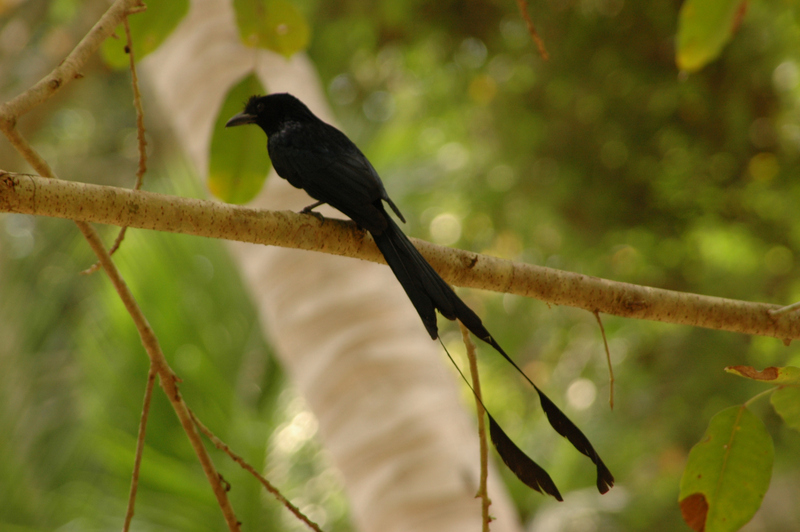Greater Racket-tailed Drongo (Dicrurus paradiseus) - Wiki Greater Racket-tailed Drongo
From Wikipedia, the free encyclopedia
[Photo] Greater Racket-tailed Drongo (Dicrurus paradiseus) taken in the Andaman Islands, apparently and endemic race. Source: http://www.flickr.com/photos/hendry/99531708/ Date 11 January 2005. Photo by Kai Hendry (http://www.flickr.com/photos/hendry/)
The Greater Racket-tailed Drongo, Dicrurus paradiseus, is a medium-sized Asian bird. The drongos are passerines restricted to the Old World tropics. They were previously classed as the family Dicruridae, but that has been much enlarged to include a number of largely Australasian groups, such as the Australasian fantails, monarchs and paradise flycatchers.
The Greater Racket-tailed Drongo is a resident breeder in tropical southern Asia from Kashmir, India and Sri Lanka east to Indonesia. This species is usually found in broadleaved forest. Three or four eggs are laid in a cup nest in a tree.
These are aggressive and fearless birds, 32 cm in length, and will attack much larger species if their nest or young are threatened. This courageous drongo usually leads the mixed feeding flocks typical of Asian jungle habitats.
The adult Greater Racket-tailed Drongo has spangled metallic green-blue plumage, and a large bill. The tail is long and shallowly forked, with the shafts of the two outermost feathers greatly extended and ending in the rackets which give this species its name. There is a head crest, prominent in the Indian race, D. p. grandis, but much reduced in some other subspecies. The young bird is duller and uncrested.
The Sri Lankan form, D. p. ceylonicus, has a smaller crest and has a long deeply forked tail without rackets. It is sometimes given specific status as Dicrurus ceylonicus.
The Greater Racket-tailed Drongo has short legs and sits very upright whilst perched prominently, like a shrike. It is insectivorous. The species is well-known as a very accurate vocal mimic, and according to Goodale and Kotagama (2006) appears to learn its alarm calls through interactions in mixed-species flocks. This is quite unusual, as avian vocal mimicry has hitherto been believed to be ignorant of the original context of the imitated vocalization (parrots are known to use imitated human speech in correct context, but do not show this behavior in nature). This drongo's context-sensitive use of other species' alarm calls is thus analogous to a human learning useful short phrases and exclamations in a number of foreign languages. Jim Corbett in his book "Jungle Lore" mentions that the Drongo can imitate to perfection the calls of most birds and of one animal the "Cheetal" and it has a great sense of humour. Attaching himself to a flock of ground feeding birds, keeps a sharp lookout for enemies in the way of hawks, cats, snakes and small boys armed with catapults and warning of the approach of danger is never disregarded.
http://en.wikipedia.org/wiki/Greater_Racket-tailed_Drongo
| The text in this page is based on the copyrighted Wikipedia article shown in above URL. It is used under the GNU Free Documentation License. You may redistribute it, verbatim or modified, providing that you comply with the terms of the GFDL. |
